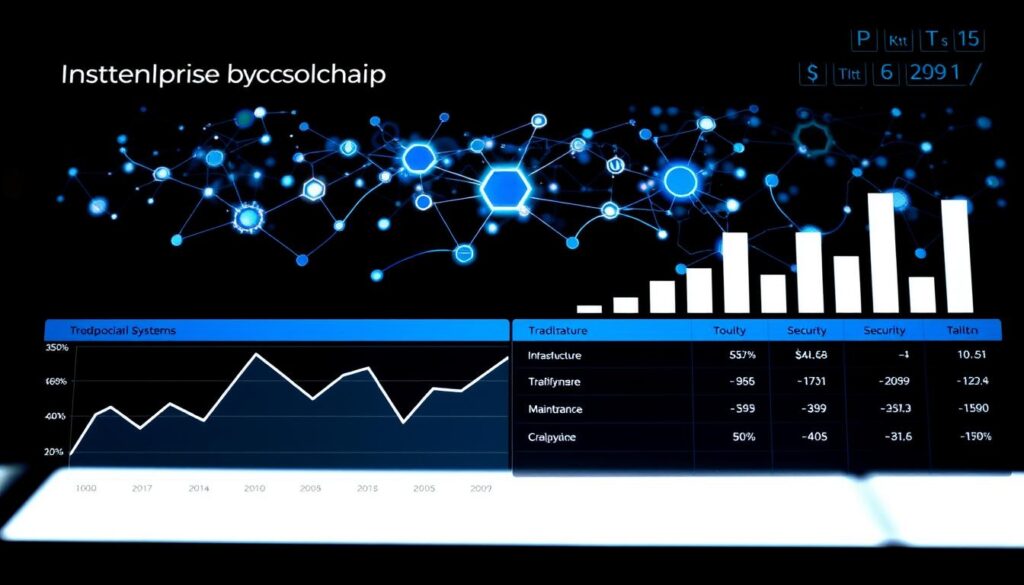Now Reading: How to Use a Crypto Swap Platform: A Beginner’s Guide
- 01
How to Use a Crypto Swap Platform: A Beginner’s Guide
How to Use a Crypto Swap Platform: A Beginner’s Guide
Starting out with cryptocurrency can feel overwhelming. A crypto swap platform is key for beginners to swap digital assets. It lets users trade one cryptocurrency for another, making it easy to mix up their investments.

For beginners, knowing how to use these platforms is vital. You need to pick a trustworthy cryptocurrency exchange. You should also understand the fees and the security steps taken.
Learning how to use a crypto swap platform well helps beginners feel ready to dive into the cryptocurrency world.
Key Takeaways
- Understand the role of a crypto swap platform in cryptocurrency trading.
- Learn how to select a reputable cryptocurrency exchange.
- Familiarize yourself with the fees associated with crypto swaps.
- Discover the importance of security measures on crypto swap platforms.
- Gain confidence in navigating the cryptocurrency market.
What Are Crypto Swap Platforms
Crypto swap platforms have changed how we trade cryptocurrencies. They make exchanging digital assets easier and faster. These platforms are key in the crypto world, helping users swap one cryptocurrency for another.
Definition and Basic Functionality
A crypto swap platform is a blockchain-based trading platform. It lets users swap one cryptocurrency for another without needing middlemen. These platforms use smart contracts for secure and clear transactions. They provide liquidity, enable trades, and sometimes offer extra services like lending or yield farming.
Centralized vs. Decentralized Swap Platforms
Crypto swap platforms come in two types: centralized and decentralized. Decentralized trading happens on blockchain platforms without a central authority. This gives users more control over their assets. On the other hand, centralized platforms are run by one entity, offering a more traditional exchange experience. Decentralization focuses on security and autonomy, while centralization is about ease of use and quick transactions.
The Evolution of Crypto Swapping
Crypto swapping has grown a lot since Bitcoin started. At first, cryptocurrency exchanges were common but had their downsides. The rise of DeFi and AMMs changed things, making direct swaps easier. Now, crypto swap platforms keep improving, adding features like cross-chain swaps to better the user experience.
The Benefits of Using Crypto Swap Platforms
Crypto swap platforms are great because they let you swap tokens instantly. This makes them perfect for those who want to quickly switch between cryptocurrencies.
Speed and Convenience
These platforms allow for peer-to-peer crypto swapping. This means you can swap coins directly, without needing someone in the middle. It makes transactions faster and easier.
Access to a Wide Range of Cryptocurrencies
They offer a wide variety of cryptocurrencies to swap. This is great for those who want to mix up their investments or swap rare coins.
Potential for Lower Fees
Crypto swap platforms usually have lower fees. This makes secure asset swapping cheaper. You can save money on fees compared to other ways of exchanging.
Privacy and Control Benefits
Using these platforms gives you more control over your assets. They focus on keeping your transactions secure and private. The main benefits are:
- Enhanced security measures
- Control over personal data
- Reduced risk of asset freezing
Overall, users get a faster, safer, and more private way to swap cryptocurrencies.
Common Types of Crypto Swap Platforms
Crypto swap platforms vary, each with its own features. They cater to different needs and preferences. It’s important to know the differences to choose the right platform for swapping cryptocurrencies.
Automated Market Makers (AMMs)
Automated Market Makers (AMMs) are a common type. They use liquidity pools for trades. Unlike traditional exchanges, AMMs trade against a pool of funds in a smart contract.
How Liquidity Pools Work
Liquidity pools are funds locked in a smart contract. They provide the needed liquidity for trades. Users swap tokens against these pools, with prices set by an algorithm.
Order Book Exchanges
Order book exchanges work like traditional stock exchanges. Buyers and sellers place orders that the exchange matches. This platform is known for its flexibility in pricing and is favored by experienced traders.
Aggregator Platforms
Aggregator platforms scan multiple exchanges for the best prices. They save users time and money by combining liquidity from various sources.
Cross-Chain Swap Solutions
Cross-chain swap solutions allow swapping cryptocurrencies across different blockchain networks. This is useful for accessing more digital assets and improving interoperability between blockchains.
In conclusion, choosing a crypto swap platform depends on individual needs. Whether it’s privacy, diverse options, or a specific trading mechanism. Understanding each platform type helps users make better choices.
Essential Tools and Requirements for Crypto Swapping
To start crypto swapping, you need the right tools. This includes a cryptocurrency wallet, knowing how to verify your identity, and keeping your data safe.
Cryptocurrency Wallets
A cryptocurrency wallet is a digital space to store, send, and receive cryptocurrencies. It’s key for swapping.
Hot vs. Cold Wallets
Hot wallets are always online, making things easy but risky. Cold wallets stay offline, offering safety but less ease. Your choice depends on what you need and how much risk you’re okay with.
Identity Verification Requirements
Most swap platforms need identity verification to follow the law. You’ll need to show personal ID and sometimes where you live.
Internet Connection and Security Measures
A good internet connection is crucial for swapping. Also, using security measures like 2FA and strong passwords helps keep you safe.

Knowing and using these tools and steps helps you swap cryptocurrencies safely and well.
Preparing for Your First Crypto Swap
Before you start with crypto swapping, getting ready is key. You need to take a few important steps. These will help you feel confident as you go through the process.
Researching Market Conditions
It’s crucial to know the market conditions right now. This means keeping up with trends, price changes, and how people feel about the market. By doing this research, you can make better choices about when and what to swap.
Setting Up a Secure Environment
Having a secure environment for your swap is a must. Use a trusted wallet, turn on two-factor authentication, and keep your devices safe from viruses. A safe setup guards your assets from harm.
Understanding Gas Fees and Network Congestion
Gas fees and network congestion can affect your swap. Gas fees are the costs of using the blockchain, and congestion happens when the network is too busy. Knowing about these can help you plan your swap better.
Creating a Swapping Strategy
Having a swapping strategy is vital for a good swap. Decide which cryptocurrencies to swap, set achievable goals, and pick the best time to swap based on the market.
By taking these steps, you can have a smooth and successful crypto swap experience.
How to Choose the Right Crypto Swap Platform
Choosing the right crypto swap platform is key for a smooth trading experience. With more people trading cryptocurrencies, there are many platforms to pick from. This makes choosing the right one harder.
User Interface Considerations for Beginners
A user-friendly interface is essential for beginners. Look for platforms that are easy to navigate. They should have clear instructions and not be too complicated. A good UI can make learning and trading more fun.
Security Features to Look For
Security is very important when trading cryptocurrencies. Make sure the platform has strong security like two-factor authentication and encryption. It should also have a good history of keeping user funds safe.
Look for regular audits and clear security plans. These are signs of a trustworthy platform.
Fee Structures and Transparency
It’s important to understand the fee structures to avoid surprise costs. Choose platforms with clear fee schedules. This includes any extra charges for deposits, withdrawals, or trades.
Some platforms offer discounts for using their tokens or for trading a lot. Keep an eye out for these.
Community Support and Resources
A platform with active community support and lots of resources is a big plus. Look for platforms with tutorials, FAQs, and quick customer support. Being part of the community can give you valuable tips and keep you in the loop with market trends.
Step-by-Step Guide to Creating an Account
Starting with a crypto swap platform is your first step into the world of cryptocurrency trading. The process is easy and safe. It lets users start swapping cryptocurrencies fast.
Registration Process
The first step is to give a valid email and create a strong password. Some sites might ask for your phone number too.
Email Verification Steps
Email verification is key to keeping your account safe. After signing up, you get an email with a link. Clicking it confirms your email and activates your account.
Verifying Your Identity (KYC)
Most platforms need you to go through a Know Your Customer (KYC) check. This means you’ll upload ID documents like a passport or driver’s license. You might also need to show proof of where you live.
Setting Up Two-Factor Authentication
Adding two-factor authentication (2FA) is a great way to make your account more secure. You’ll link your account to an app or get SMS codes. These are needed when you log in or make transactions.
By doing these steps, you can make a safe and verified account. Then, you’re all set to start swapping cryptocurrencies.
Connecting Your Wallet to a Crypto Swap Platform
Connecting your wallet to a swap platform is easy and opens up trading opportunities. It’s important to know the steps and what to consider.
Compatible Wallet Options
Most swap platforms support wallets like MetaMask, Trust Wallet, and Coinbase Wallet. Think about security, ease of use, and platform compatibility when picking a wallet.
- MetaMask: A popular browser extension wallet known for its ease of use and robust security features.
- Trust Wallet: A mobile wallet that supports a wide range of cryptocurrencies and is user-friendly.
- Coinbase Wallet: A reputable wallet that integrates well with Coinbase’s exchange services.
Connection Process
The connection process is simple. First, make sure your wallet is set up and funded. Then, go to the swap platform and choose to connect your wallet.
- Go to your wallet and access the settings or connection options.
- On the crypto swap platform, find the wallet connection feature.
- Follow the prompts to link your wallet to the platform.
Browser Extensions vs. Mobile Apps
You can connect your wallet with a browser extension or a mobile app. Browser extensions are great for desktop users. Mobile apps are better for trading on the go.
Troubleshooting Common Connection Issues
Users sometimes face issues when connecting their wallet. Common problems include:
- Network errors: Ensure you’re on the correct network (e.g., Ethereum, Binance Smart Chain).
- Wallet not recognized: Check that your wallet is supported and properly configured.

Knowing about compatible wallets, the connection process, and troubleshooting can help you easily connect your wallet. This way, you can start trading without any hassle.
Navigating the User Interface of Swap Platforms
Understanding the user interface of crypto swap platforms can be tough. But knowing its parts is key for smooth trading. The interface helps you navigate and make smart choices, making trades easy.
Understanding Trading Pairs
At the core of crypto swap platforms are trading pairs. A pair lets you swap one cryptocurrency for another. For instance, ETH/BTC lets you trade Ethereum for Bitcoin. Knowing how to read these pairs is vital for using the platform well.
It’s also important to know that a pair’s liquidity and volatility can affect swaps. To do well, keep up with market trends and adjust your plans.
Reading Market Data and Charts
Market data and charts give insights into the crypto market. By looking at market data, traders can spot trends and make smart swap choices. Charts show market changes, helping users grasp market dynamics.
Locating Essential Functions
Getting to know the user interface means finding key features like the swap button and settings. These are important for managing trades and keeping track of your account. Knowing where these are and how to use them helps avoid mistakes.
Mastering the user interface is crucial for a good trading experience on crypto swap platforms.
Executing Your First Swap Transaction
Learning how to swap cryptocurrencies is key for effective trading. It involves several important steps for a smooth transaction.
Selecting Cryptocurrencies to Swap
The first step is to pick the cryptocurrencies you want to swap. Most platforms have an easy-to-use interface showing available pairs. Think about the market and your strategy when choosing.
For more on crypto swaps versus traditional exchanges, check this comparison.
Setting Transaction Parameters
After picking your cryptocurrencies, set your transaction details. Decide how much to swap and your slippage tolerance. Slippage tolerance is key as it shows how much price change you can handle.
Slippage Tolerance Settings
Slippage tolerance is crucial for managing risk from price changes. A higher tolerance means a bigger price difference, but a lower one might cause the swap to fail if prices move too fast.
Confirming and Executing the Swap
After setting your parameters, double-check the details before confirming. Make sure everything is right, including the amount and slippage tolerance. Confirming the swap exchanges your cryptocurrencies.
Tracking Your Transaction
After the swap, track it. Most platforms show a transaction history or status updates. Keeping an eye on your transaction lets you know it’s done.
By following these steps, you can swap cryptocurrencies with confidence. Always stay updated on market conditions and adjust your plans as needed.
Understanding Swap Fees and Price Impact
To use crypto swap platforms well, knowing about fees is key. These fees can change the cost of your trades. It’s important to understand them to save money and get more value from your transactions.
Types of Fees Involved
Crypto swap platforms have different fees. There are transaction fees, network fees (gas fees), and service fees. Transaction fees are for the swap service. Network fees go to the blockchain validators. Service fees are for extra services.
How Price Slippage Works
Price slippage happens when the swap price changes due to market shifts. This can lead to a worse exchange rate than expected. Knowing about price slippage helps manage your expectations and reduce its effect on your trades.
Strategies to Minimize Costs
To cut costs on crypto swap platforms, try a few things. Set slippage tolerance levels and use limit orders instead of market orders. Also, pick platforms with lower fees. These steps can help lower the costs of swapping cryptocurrencies.
Managing Risks When Using a Crypto Swap Platform
Using crypto swap platforms comes with risks. It’s important to know these risks to use these platforms well.
Market Volatility Considerations
Crypto markets are very volatile. Prices can change quickly. To handle this, stay updated on market trends and be ready for price changes.
Don’t invest more than you can afford to lose. Set realistic goals for your investments.

Security Best Practices
Security is key when using crypto swap platforms. Follow security best practices like two-factor authentication and strong passwords. Keep your software updated.
Be careful of phishing scams and other threats.
Setting Realistic Expectations
It’s important to have realistic expectations when swapping crypto. Understand that big gains come with big risks. Know the market well before investing.
Don’t invest based on speculation or hype.
Using Stop-Loss and Limit Orders
Stop-loss and limit orders can reduce losses. A stop-loss order sells your crypto when it hits a certain price. This limits your losses.
Limit orders let you set a price to buy or sell. This gives you control over your transactions.
Advanced Swapping Techniques
For those looking to improve their crypto swapping skills, advanced techniques are key. Multi-hop swaps and limit orders on DEXs are especially useful. These strategies help traders better navigate the complex crypto market.
Multi-hop Swaps
Multi-hop swaps are a powerful tool in some crypto swap platforms. They allow users to swap one cryptocurrency for another, even without a direct liquidity pool. This is done by routing the swap through one or more intermediate cryptocurrencies.
For example, if a user wants to swap Token A for Token C but there’s no direct pool, the platform can use Token B. This is possible if there are liquidity pools for Token A/Token B and Token B/Token C. This method increases the chance of finding profitable trades and boosts liquidity.
Limit Orders on DEXs
Limit orders on Decentralized Exchanges (DEXs) offer traders more control. Unlike market orders, which execute immediately, limit orders let users set a specific price for buying or selling. This is especially useful in volatile markets.
By setting a limit order, traders can automate their strategy. This ensures they don’t miss out on potential gains. It’s a great way to capitalize on price movements without constantly watching the market.
Yield Farming Through Swaps
Yield farming through swaps involves using swap transactions to earn extra income or rewards. This can be done by participating in liquidity pools or using specific platforms that offer yield farming opportunities. For example, users can provide liquidity to a pool and earn a portion of the transaction fees.
They might also receive additional tokens as a reward. Yield farming can be very profitable, but it’s important to understand the risks, like impermanent loss.
Troubleshooting Common Issues on Crypto Swap Platforms
Crypto swap platforms make trading easy, but sometimes problems pop up. Knowing how to fix these issues can make your trading better.
Failed Transactions
Failed transactions can be a bummer. They often happen because of insufficient gas fees or network congestion. Try upping the gas fee or checking the network status to fix it.
- Check if the network is congested.
- Increase the gas fee to prioritize your transaction.
- Ensure you have sufficient funds in your wallet.
High Gas Fees
High gas fees can make trading expensive. To lower costs, you can adjust the gas fee settings on your platform or use a gas fee estimator tool.
- Use a gas fee estimator to find the best fee.
- Adjust your gas fee settings accordingly.
- Swap during off-peak hours to save.
Price Impact Warnings
Price impact warnings happen when your swap changes the market price a lot. To avoid this, try splitting your swap into smaller transactions or using a different liquidity pool.
- Split large swaps into smaller ones.
- Use a different liquidity pool.
- Watch market conditions before swapping.
Wallet Connection Problems
Wallet connection issues can block you from using your funds. Make sure your wallet is compatible with the swap platform and your connection settings are correct.
- Check wallet compatibility.
- Verify connection settings.
- Update your wallet software if needed.
Tax Implications of Crypto Swapping
When you’re into crypto swapping, knowing about taxes is key. Swapping cryptocurrencies comes with tax rules you must follow. This ensures you’re in line with tax laws.
Swaps as Taxable Events
In the U.S., the IRS sees crypto swaps as taxable. This means every swap is seen as selling one crypto and buying another. This can lead to gains or losses, depending on the swap type and how long you held the crypto.
Record-Keeping Best Practices
Keeping good records is crucial for reporting crypto swaps on your taxes. Here are some best practices:
- Document the swap date and time
- Record the swapped crypto types and amounts
- Note the USD value of the crypto at swap time
- Track any swap fees
Using crypto tax software can make this easier.
Tools for Crypto Tax Reporting
There are many tools for crypto tax reporting, like:
- Crypto tax software that works with exchanges and wallets
- Spreadsheets for tracking and calculating manually
- Professional tax services for crypto
The right tool depends on your crypto activities and tax comfort level.
The Future of Crypto Swapping and What It Means for You
The future of crypto swapping is changing fast. This is thanks to new blockchain tech and the need for DeFi solutions. Users will soon see better security, lower fees, and easier-to-use platforms.
Cross-chain swap solutions are becoming more popular. They let users easily move money between different blockchains. This makes crypto swapping more user-friendly and accessible.
Automated market makers (AMMs) and aggregator platforms are also on the rise. They improve liquidity and offer better prices. This strengthens the role of crypto swap platforms in the market.
As the crypto swapping world keeps changing, it’s important to stay up-to-date. Knowing what’s coming can help you make smarter choices. It lets you trade cryptocurrencies with more confidence.
FAQ
What is a crypto swap platform?
A crypto swap platform lets users swap one cryptocurrency for another. It’s a quick and easy way to exchange digital coins without using traditional exchanges.
How do I choose the right crypto swap platform?
Look at the platform’s user interface, security, fees, and community support. Choose one that’s easy to use, secure, has clear fees, and good customer support.
What are the benefits of using a crypto swap platform?
Using a crypto swap platform is fast and convenient. It offers access to many cryptocurrencies, possibly lower fees, and more privacy. It’s a great way to swap coins easily.
What is the difference between centralized and decentralized crypto swap platforms?
Centralized platforms are run by a single authority. Decentralized ones use blockchain for peer-to-peer transactions. Decentralized platforms are more secure and transparent, while centralized ones are easier to use.
How do I ensure the security of my assets on a crypto swap platform?
Choose a reputable platform with strong security like two-factor authentication and encryption. Use a secure internet, keep your software updated, and watch your account regularly.
What are the tax implications of crypto swapping?
Swapping cryptocurrencies is taxable. You must report your gains and losses on your taxes. Keep detailed records and talk to a tax expert to follow the rules.
How do I troubleshoot common issues on a crypto swap platform?
Issues like failed transactions or high fees can happen. Check the platform’s help, contact support, and adjust your settings to fix problems.
What is a liquidity pool, and how does it work?
A liquidity pool is a fund in a smart contract that helps with swapping cryptocurrencies. It makes swapping efficient and stable. Liquidity pools are key in DEXs and AMMs.
How do I connect my wallet to a crypto swap platform?
To connect your wallet, follow the platform’s instructions. This might involve using a browser extension, app, or hardware wallet. Make sure your wallet is compatible and secure.















